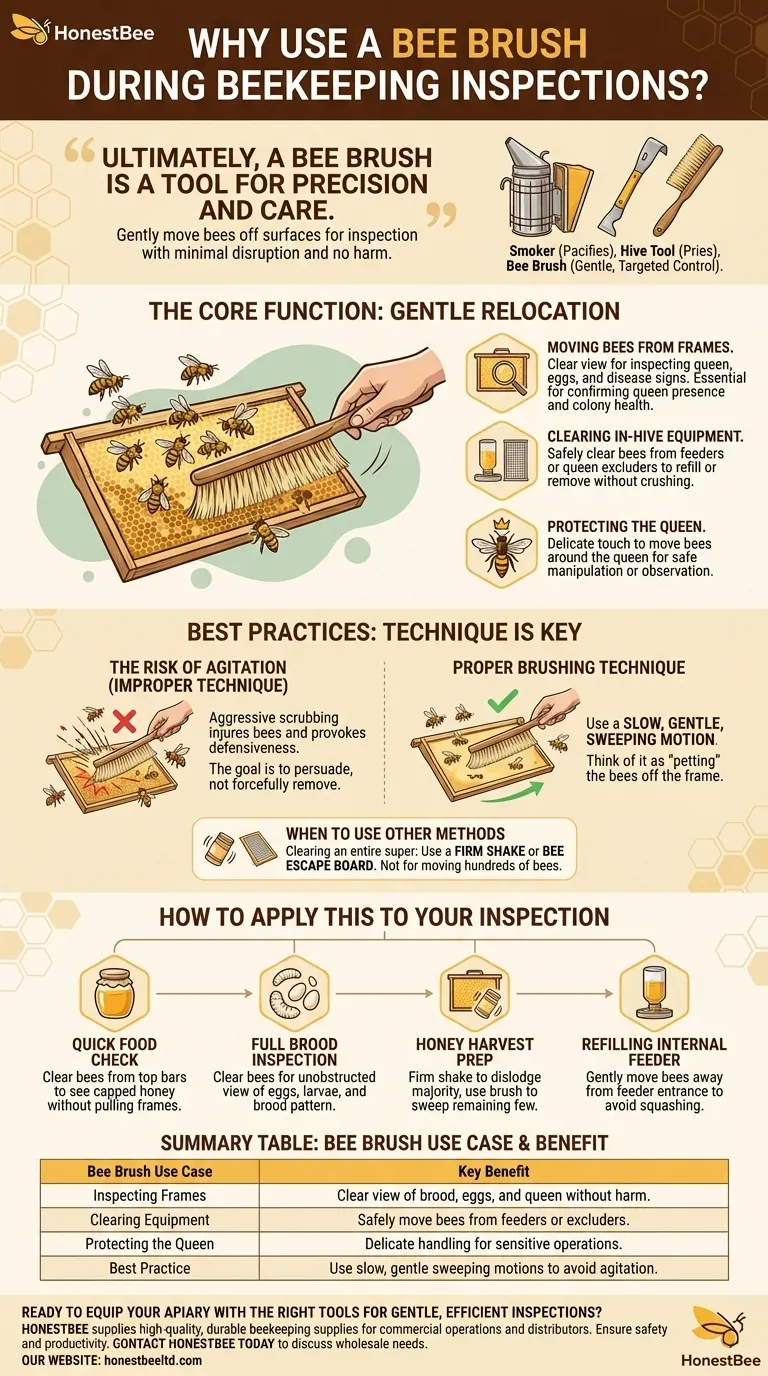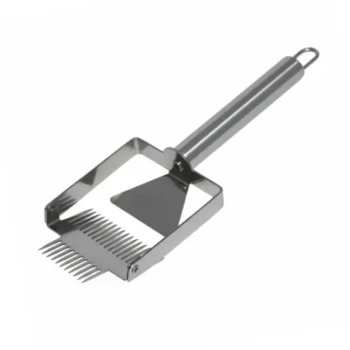Ultimately, a bee brush is a tool for precision and care. It is used to gently move bees off surfaces you need to see or handle, such as a frame, the inner cover, or an in-hive feeder. This allows you to perform your inspection or management tasks with minimal disruption and without harming the colony.
A successful hive inspection is calm, efficient, and minimally disruptive to the bees. While a smoker pacifies the colony and a hive tool pries things apart, a bee brush provides the gentle, targeted control needed to work safely and effectively.

The Core Function: Gentle Relocation
A bee brush's primary purpose is to move bees from one place to another without causing injury or alarm. This simple function is critical during several key moments in a hive inspection.
Moving Bees from Frames
To properly inspect a frame for the queen, eggs, or signs of disease, you need a clear view. A gentle sweep with a bee brush clears the surface, giving you an unobstructed look at the comb and brood pattern.
This is especially important when you need to confirm if a queen is present or assess the health of your colony's next generation.
Clearing In-Hive Equipment
Bees will often cover equipment like in-hive feeders or queen excluders. Using a brush allows you to clear them away so you can refill the feeder or remove the excluder without crushing any bees in the process.
Protecting the Queen
If you spot the queen, you may need to move the bees around her to get a better look or to ensure she is safe before you manipulate or close up the hive. A brush offers the delicate touch needed for this sensitive operation.
Understanding the Trade-offs and Best Practices
While a bee brush is an essential tool, its effectiveness depends entirely on how it is used. Simply having one is not enough; technique is what separates a helpful tool from a source of agitation.
The Risk of Agitation
An improper brushing technique can be counterproductive. Aggressively scrubbing or flicking the bees will injure them and provoke a defensive response, making your inspection more difficult.
The goal is to gently persuade, not forcefully remove.
Proper Brushing Technique
The correct method is a slow, gentle, sweeping motion. You are essentially ushering the bees to move along. The long, soft bristles are designed to be non-injurious, but only when used with a light touch.
Think of it as petting the bees off the frame rather than sweeping them.
When to Use Other Methods
A bee brush is for targeted clearing. If you need to clear an entire super of bees for honey harvest, a firm shake or a bee escape board is far more efficient. The brush is not the right tool for moving hundreds of bees at once.
Likewise, a smoker is for calming the general mood of the hive, not for clearing a specific surface. Each tool has its precise role.
How to Apply This to Your Inspection
An organized toolkit makes for a faster, easier, and less stressful inspection. Knowing which tool to use, and when, is the mark of a confident beekeeper.
- If your primary focus is a quick check of food stores: A bee brush helps clear bees from the top of frames so you can see the capped honey without pulling the frame.
- If you are performing a full brood inspection: A brush is essential for gently clearing bees to get an unobstructed view of eggs, larvae, and the brood pattern.
- If you are preparing to harvest honey: Use a firm shake to dislodge the majority of bees from a honey frame, then use the brush to sweep off the few that remain.
- If you need to refill an internal feeder: A brush is the perfect tool to gently move the bees away from the feeder entrance without squashing them.
Using the right tool for the job demonstrates respect for the bees and streamlines your work, making beekeeping a more successful and rewarding endeavor.
Summary Table:
| Bee Brush Use Case | Key Benefit |
|---|---|
| Inspecting Frames | Clear view of brood, eggs, and the queen without harm. |
| Clearing Equipment | Safely move bees from feeders or excluders. |
| Protecting the Queen | Delicate handling for sensitive operations. |
| Best Practice | Use slow, gentle sweeping motions to avoid agitation. |
Ready to equip your apiary with the right tools for gentle, efficient inspections?
HONESTBEE supplies commercial apiaries and beekeeping equipment distributors with high-quality, durable beekeeping supplies. Ensure your operations are safe for your bees and productive for your business.
Contact HONESTBEE today to discuss your wholesale needs and discover our full range of professional beekeeping equipment.
Visual Guide

Related Products
- Professional Dual-End Stainless Steel Hive Tool for Beekeeping
- Multi-Function Plier-Style Frame Grip Hive Tool
- HONESTBEE Professional Multi-Functional Hive Tool with Ergonomic Wood Handle
- Professional Stainless Steel Pry-Bar Hive Tool
- HONESTBEE Professional Long Handled Hive Tool with Precision Cutting Blade
People Also Ask
- What should beginners consider when purchasing beekeeping equipment? A Guide to Essential Starter Gear
- What are the normal functions of a hive tool? The Essential Multi-Tool for Every Beekeeper
- What are the basic tools for beekeeping? Essential Starter Kit for Safe & Successful Hive Management
- Why is proper beekeeping equipment important? Essential for Safety and Hive Health
- What temperature is too cold to open a beehive? Protect Your Hive from Fatal Cold Shock



















